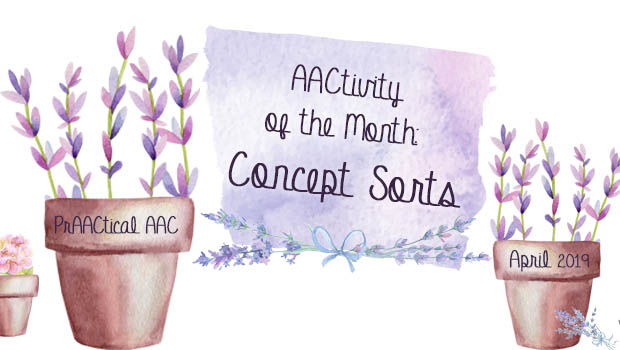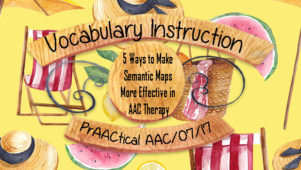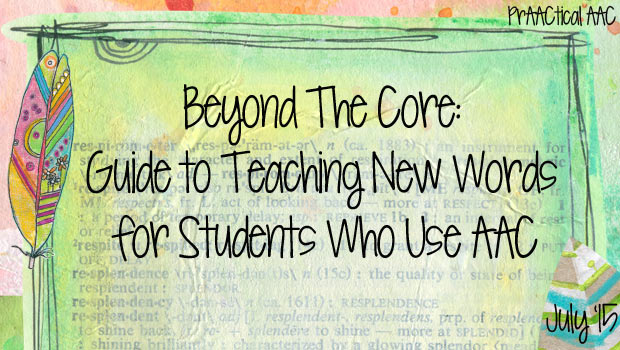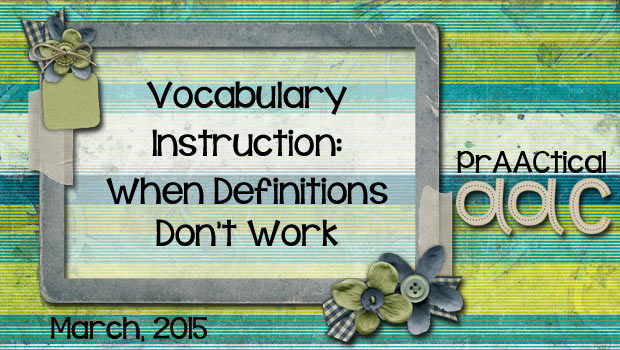AACtivity of the Month: Concept Sorts

Concept Sorts (learn more here) are often used in vocabulary intervention and academic instruction. Chances are, you’re probably using them already with some of your learners. These easy-to-implement activities can be helpful in teaching AAC as well.
There are lots of right ways to do a concept sort. Here is one of them.
- Select a target word. Print out 2 copies of the AAC symbol for it, and the symbol for No/Not as it appears in the learner’s AAC system. Use these to create a simple 2-column sorting system (e.g., 2 shallow boxes, one with the target word symbol and the other with No/Not + target symbols).
- Gather a collection of objects or pictures that depict or are related to the target word.
- Gather a collection of objects or pictures that depict the opposite of the target word or show something completely unrelated.
- Put the objects or pictures to be sorted together into a pile, bag, or box. There should be a mix of objects or pictures that are positive examples of the concept and those that do NOT represent or are NOT associated with the concept.
- For each turn, the learner selects an object or picture from the stack.
- Look at the object/picture with your learner and discuss it. Decide whether that object/symbol belongs in the box for the new concept (the ‘Yes’ box) or whether it fits better in the box of opposite or unrelated items (the ‘No’ box). The goal of this step is to use AAC to discuss which box each item goes into and place it there.
- This is not an independent work task. The dialogue is a critical element here and creates a rich language learning experience.
- Talk about the salient characteristics and attributes with the learner. Relate what you see and know about each item to the target concept.
- Use aided language input, descriptive talking, think-aloud, and other instructional strategies throughout these conversations.
- Example: Target concept – Wet
Picture of kids getting out of the bathtub: “Let’s see. There is a lot of water in that tub. They had a good bath and got all washed and clean. They are climbing out. And Dad’s getting ready with the towel. What do you think? Should it go with our WET pictures or our NOT WET pictures?”
Picture of kids going into school: “Let’s look at this one. They are all ready for school, aren’t they? School clothes on. They’re happy to see their friends. They have their backpacks. Any water around? I don’t see any. What do you think? Should it go with our WET pictures or our NOT WET pictures?”
7. Informative Feedback: Based on the learner’s response, provide feedback on whether they are on the right track or not.
-
- If they are correct, expand
- If they are incorrect, point out the inaccuracies and talk about them. At this point, you can do one of two things.
- Express curiosity. Since their response is not the expected one, it seems wrong to us. It MAY be wrong, OR the learner may have something else entirely in mind that demonstrates he/she/they really do understand the concept. Rather than assuming that the unexpected answer is wrong, try to find out why the learner is giving this answer. For example, Sasha wanted to put the picture of kids going into school into the wet column, which seemed incorrect initially. “I’m not seeing anything wet. I wonder why you want to put it with our WET things.” When Sasha pointed to a water bottle that a student was carrying, it indicated that her thinking was indeed on track. We talk about how water bottles and wet go together, place the picture in the WET column and move on.
- Another option is to steer the conversation toward the salient attributes that the learner may have missed. Use language that helps the learner see why this picture is NOT a good representation of our concept. “They look dry to me. NO water on their clothes. NOT wet on the ground. NO rain in the sky. Hmmm…Let’s see. Should we put them with WET things or NOT wet things?”
- The purpose here is to inform, clarify, and solidify their understanding of this concept. Our feedback should be instructional, and the context is a conversation we build around the elements of the picture that do and do not correspond with the new concept.
8. Depending on the learner and his/her/their AAC, you may get through a whole stack of objects/pictures. If you are working with learners who fatigue or just lose interest, plan to do just a portion of the stack rather than aiming to get through them all.
-
- Don’t rush this. The conversation is where the richness is.
- Take time to discuss, wonder, explore, consider, and relate. All the while, you are infusing the target concept word into your conversation along with supportive strategies like aided language input, focused language stimulation, recasts, descriptive talking, etc.
- The goals are a) to build an understanding of the target concept, and b) to gain experience saying that new word using AAC.
9. Once you’ve finished sorting for this particular lesson/session, you can squeeze in a bit more language learning but doing a quick review of each column.
-
- Example of positive exemplars: “We found a lot of WET things, didn’t we? This baby got WET in the tub and splashed all that water on the floor. And look at this lady with her umbrella. She is getting rained on, isn’t she? She’s stepping around the puddle so her shoes don’t get WET. It’s a rainy, WET day. What’s next? Juice boxes! Full of WET apple juice. And there’s the straw so that we don’t spill it and get everything WET and sticky.”
- Example of negative exemplars: “We said these things are NOT wet. She’s reading a book. No water near her. Everything looks nice and dry. Nothing WET here. What about this one? He is blowing out candles on his cake. Do you see anything WET? Nope, me neither. Next, we have this car. No rain, no puddles, no water. I remember why we said this one goes with NOT WET.”
- Remember, conversation provides a rich context for language learning. Use the strategies we discussed previously to help this new content knowledge stick.
“How can I incorporate this into my AAC teaching?”
Here are a few ideas to get those creative juices flowing.
- Core Vocabulary: Hopefully, the team is already providing lots of exposure to the target core words in natural conversation and instruction throughout the day, and pausing to create opportunities for the learner to say the target words in meaningful contexts. We can add this activity as a more direct way to focus on what that specific core word means, and work through lots of positive and negative examplars.
- Compare and Contrast: When working with learners who already know a lot of other concepts and words, you can modify the activity so that they are comparing and contrasting. Instead of sorting WET and NOT WET, you may be sorting WET and DRY.
- 2-word Sentences: While you are building concept and vocabulary knowledge you can also model and elicit multi-word sentences. If your learner is new at sentence-building, you may want to stick to the same type of sentence structure throughout the activity. For example, Pronoun + Descriptor give us lots of opportunities to combine he/she/it and wet.
- Fringe and Tier 2 Vocabulary: This is an excellent activity to build concept and word knowledge for vocabulary that is used less frequently. These can be other common fringe words (e.g., nice, outside, day, people) or academic vocabulary (e.g., line, construct, sufficient, annoy). Remember, students do not need to ‘master’ their core words before learning these other kinds of words. Every situation is different, and there are many times when it makes both to teach several kinds of words simultaneously.
- Syntax and Word Order: As language emerges, some AAC learners struggle with putting words in the right order to create a meaningful sentence. We can model appropriate word order and give lots of practice in using it with a concept sort activity.
Do you use Concept Sorts in your AAC work? We’d love to hear about it.
Filed under: Featured Posts, PrAACtical Thinking
Tagged With: semantic instruction, vocabulary intervention
This post was written by Carole Zangari





2 Comments
This is a really helpful, practical article – thank you!!
You’re very welcome, Laura. Stay tuned for more AAC teaching activities like these. Thank you for taking the time to comment!